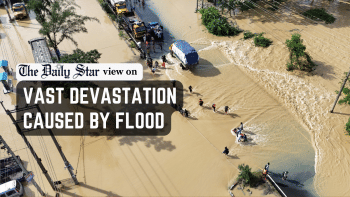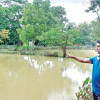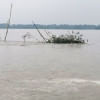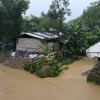Rethinking Disaster Response: We ignore indigenous knowledge at our peril

Natural disasters such as floods, cyclones, heatwaves, or droughts create vulnerabilities in ecosystems and human life. A hazard does not increase the risk of harm equally for everyone nor does everyone suffer equally. Economic, environmental, social, and political factors play into this equation. Besides, hazards like floods do not occur after issuing a notice. Therefore, preparations are necessary so that these hazards don't increase harm. This preparation should occur at individual, familial, societal, and state-level ecosystems, as well as transnationally, regionally, and globally.The better the preparation, the lesser the risk and damage.
While the same disaster does not affect everyone equally, the suffering of certain groups or communities is intentionally kept away from the public eye. Social marginalisation, structural inequality, neoliberal corporate markets, or state authority increase the risks for people and ecosystems. Simply providing relief, assistance, or infrastructure development is not enough, in any measure, to tackle disaster-borne risks and the resulting destruction. We need thorough reforms at all levels and establish a universal, participatory, and inclusive disaster management system.
It is not just enough to include people of all classes, professions, ages, and genders from all parts of the country in the disaster management process. Their participation must be meaningful. The contributions and work of the people involved in disaster management must be recognised, and a dignified disaster management framework must be established. Even though we have celebrated the golden jubilee of our independence, we have not been able to build an inclusive disaster management framework. The reason behind this is the deeply rooted hegemony, the arrogance of power, binary perspectives, and authoritarianism within us. This has been true with all the authoritarian regimes of the past.
Bangladesh's disaster management framework is often presented as a good example on the global stage. People say that the state responds quickly to disasters. However, the state is only active when a disaster strikes, spending the rest of the time in outright hibernation. Besides, our disaster preparedness and management are not uniform across regions. Only cyclone-prone coastal areas have shelters, but drought-prone Barind and flash flood-prone haor regions don't have many.
In the recent floods in Feni, Lakshmipur, Khagrachhari, and Noakhali, we saw increased suffering and losses due to the lack of disaster preparedness. The state must give equal importance to all geographically diverse regions and social classes in disaster preparedness. We must change our tendency to ignore and neglect the protection of people, biodiversity, and ecosystems. There are 30 agroecological zones and 17 hydrological zones in the country. Then there is the Barind region, wetlands, chars, coastal areas, forests, hills, plains, and urban areas. The nature of disasters and damage is not the same across these regions, neither is the impact on various social groups equal. Knowing and understanding local knowledge and community actions on disaster management is crucial.
We have not yet integrated indigenous disaster preparedness knowledge into the national disaster management framework. Authoritarian knowledge frameworks have always marginalised local knowledge. Today, it is hard to find rural societies in Bangladesh where Khonar Bachan (Khona's sayings) is actively practised. Much of the indigenous knowledge and strength to prepare for disasters have tragically been lost. Today, in many villages, it is rare to find young people who know how to read the signs of an imminent flood, drought, or disaster. Few places retain their local genetic resources and natural assets that have for many years played a sustainable role in preparing for disasters and recovering from the crisis afterwards.
So, how should we prepare for disasters? Should we continue to validate false neoliberal solutions repeatedly in the name of disaster management, that do not foster disaster-resilient communities in any way, but rather legitimise corruption, mismanagement, profiteering, land grabbing, and corporate markets in the name of disaster management? An investigation is urgently needed into why we had to lose local knowledge and region-specific disaster management expertise. It's also crucial to examine the role of the state and authoritarian regimes in this loss.
Loss and damage debate and community resilience
In every disaster, three phases of preparedness are critical—before, during, and after. According to the global Sendai Framework targets, the top priority during a disaster is to respond quickly and save lives and property. Another post-disaster priority is rehabilitation. However, there's a long-standing debate about agricultural, fisheries, and livestock rehabilitation. Instead of genuinely helping the devastated and impoverished, this kind of rehabilitation covertly targets the poor to turn them into consumers of multinational corporations.
It has been observed that floods, cyclones, hailstorms, cold injuries, droughts, or salinity cause the loss of many crop varieties, including rice. Many fish and livestock are lost, and wildlife either vanishes or leaves their habitats. Every disaster leaves a painful scar of loss on nature and culture. Is it possible to "rehabilitate" this loss? Can mere financial compensation ever restore the lost resources? Can sacks of money bring back the grains and the songs lost to floods? If native salt-tolerant varieties disappear from a coastal village due to a disaster, offering hybrid seeds in sealed packets is not a sustainable solution for agricultural rehabilitation. Instead, it creates new crises and sufferings.
So, what should our post-disaster agricultural rehabilitation system look like? Essentially, we must develop a protection and rehabilitation system based on indigenous knowledge and local genetic resources that are severely affected by every disaster. In modern climate discourse, this is called Loss and Damage (L&D). L&D can be both economic and non-economic and the latter is not discussed frequently. The state has never created any list or report of non-economic loss and damage.
If the August 2024 floods caused varieties of rice, beliefs, folklore, songs, indigenous knowledge, or native seeds to be lost, will the state include them in their national loss report? These lost genetic and cultural resources are integral parts of the history and identity of rural communities. What steps will the post-July uprising state take to protect the country's indigenous biodiversity and traditional knowledge systems in flood-affected regions? What kind of rehabilitation programmes is the state planning? Will the state continue to ignore the people's genetic resources and knowledge systems, just like the previous authoritarian regimes? Will it flood the villages with packet seeds from stores? Will it promote the business of multinational seed companies in the name of post-flood agricultural incentives? How different will the post-flood rehabilitation in terms of agricultural issues be from those of previous regimes?
We need to search for the answers to these fundamental questions as part of state reform. Protecting genetic resources and traditional knowledge as part of disaster preparedness and management must be included in the constitution. Neoliberal authorities must be dismantled in national disaster management and agricultural rehabilitation. The spirit of the student and people-led July uprising can fuel this effective transformation.
We must avoid a repeat of post-1998 flood actions
Following the 1998 floods, the National Seed Board authorised private companies to import 2,200 metric tonnes of hybrid seeds to avoid a shortage of food grains. Companies such as ACI, Ganges, McDonald, and Molika Seed were awarded contracts to import hybrid seeds under certain conditions, but none fulfilled the contract terms. Later, it was found that many companies were registered for seed trade. These companies deceived farmers by selling substandard seeds. The deception of Syngenta, which sold the hybrid tomato seed "Sabal" in 2010 in the Barind region, became widely discussed. Despite protests and lawsuits against Syngenta, the state could not ensure seed justice for farmers. The student-people uprising of July called for state reform. We need similar reforms in our authoritarian perspectives and activities when it comes to post-flood rehabilitation and disaster management. For each flood-affected region, disaster relief and rehabilitation programmes must be formulated based on farmers' opinions and participation to create a nature-and-culture-friendly approach. Indigenous genetic resources and traditional knowledge protection should be recognised as a powerful community-based disaster preparedness strategy. The establishment of seed banks in every village and a national farmer-to-farmer seed exchange programme must be incorporated into the state's agricultural strategy. The August floods have also caused extensive damage to fisheries and livestock. Our native breeds are more capable of withstanding disasters. Therefore, prioritising indigenous breeds and traditional livestock management systems is crucial.
A longer version of this article can be found in Bangla on The Daily Star's website.
Pavel Partha, an ecology and biodiversity conservation researcher, is director at Bangladesh Resource Centre for Indigenous Knowledge (BARCIK). He can be reached at [email protected].
Views expressed in this article are the author's own.
Follow The Daily Star Opinion on Facebook for the latest opinions, commentaries and analyses by experts and professionals. To contribute your article or letter to The Daily Star Opinion, see our guidelines for submission.

 For all latest news, follow The Daily Star's Google News channel.
For all latest news, follow The Daily Star's Google News channel. 











Comments